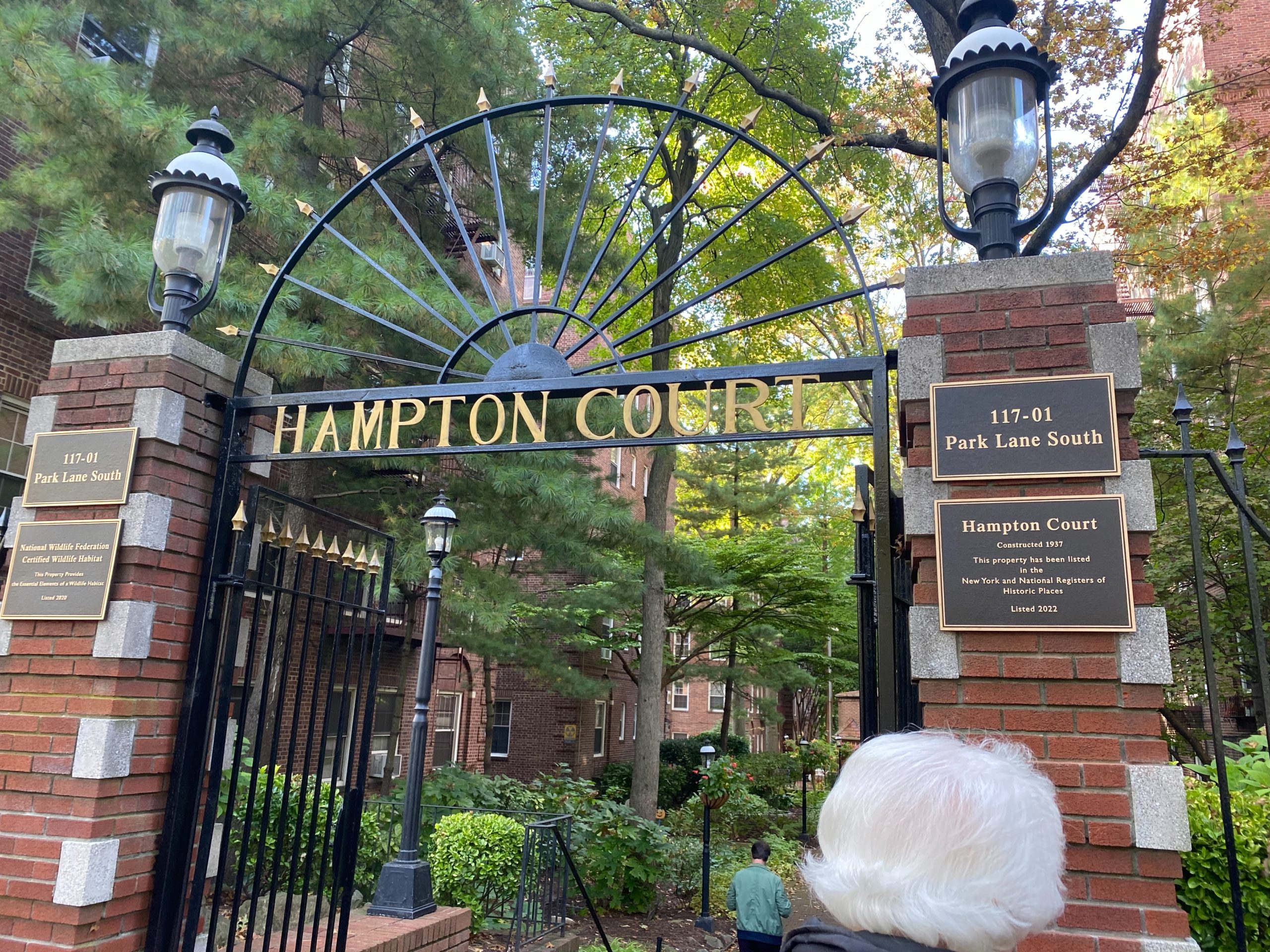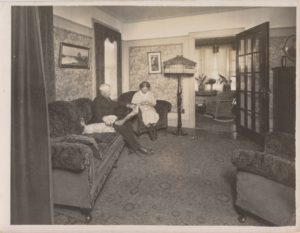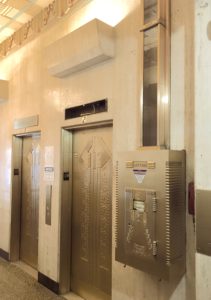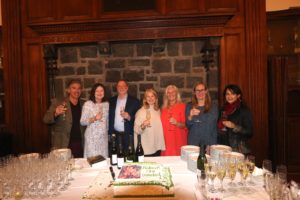A taste of Hungary in Forest Hills

By Michael Perlman
mperlman@queensledger.com
One mom and pop shop that reads NYC all over it is Andre’s Hungarian Bakery, which has enticed palates with authenticity for generations.
This cultural gem has welcomed patrons since 1976 at 100-28 Queens Boulevard in Forest Hills, and today it is one of the last-of-its-kind traditional kosher bakeries, especially for Queens.
Their slogan, “Where pastry is art,” comes alive as soon as patrons encounter the window display and enter the small, yet charming and nostalgic shop, where the experienced staff complements the culinary experience with a smile.
Rose Heimann (1919-2018), who emigrated from Hungary, is the original owner who achieved the American Dream.
“She asked me what I should name it, and I said to name it ‘Andre’s Hungarian Strudels & Pastries,’” her 73-year-old son, Andre Heimann, said.
With much faith, she granted life to an empty storefront, and as of 1981, he entered the business and they both became faces of the community.
The ambiance features cases and shelves of Hungarian pastries, stained glass fixtures and bricks, and shelves of native collectibles with a tributary photo of “Grandma Rose.”
“I’ve kept the bakers and all of the old recipes and traditions of the holidays alive,” Heimann said. “She deserves all the credit in the world, and the fact that the Forest Hills mom and pop shop is there after 40 years, is something very few stores can say. People took Andre’s home for the holidays and they still are.”
Despite today’s rise in chains and shift in real estate values, the ownership and staff at Andre’s, who considers themselves “a family,” is determined to persevere by continuing to bake Hungarian pastries by hand the old-fashioned way, while using the finest ingredients.

Fatima Auwar, Tino Melendez, Lucio Carlos behind delectable Hungarian pastries.
At the time that Andre’s opened its doors, the neighborhood was dotted by kosher and traditional bakeries, delis and butchers, including Jay Dee Bakery, Evelyn’s Bake Shop, Peter Pan, Sandy’s Surf Delicatessen, Boulevard Delicatessen, Ben’s Best, Glick’s, and Lazar’s.
Traditional favorites that are bursting with flavor are plentiful and include blueberry, plum and apple pies, Napoleon, rugelach, babka, strudel, Sacher torte, Dobos torte, croissants, Linzer tarts, fruit squares, danishes, assorted cookies, floden and beigli.
To become better acquainted, babka is a sweet yeast cake swirled with either chocolate or cinnamon raisin.
Their classic rugelach features nuts, raisins and a mix of apricot and raspberry jelly, whereas chocolate rugelach offers a rich chocolate filling and a hint of hazelnut.

Classic Rugalech
Layers of walnut and poppy seed come together with prune lekvar on top, if one is craving for Floden.
An artful beigli pastry consists of sweet yeast bread, complemented by dense walnut or poppy seed filling.
Sacher torte is a dense chocolate sponge cake with chocolate glazing and layers of apricot jam and finely grounded nuts, invented by Franz Sacher in 1832 for Prince Metternich of Vienna.
Dobos torte is a layered sponge cake with chocolate buttercream, topped off with caramel, and named after Hungarian chef József C. Dobos, a Budapest delicatessen owner who invented it in 1885.
Adding to traditions, Andre helped develop an online presence in relatively recent times, which included shipping baked goods countrywide.
The website further engages patrons with a behind-the-scenes clip titled, “Making Strudel.”
This legendary dessert is prepared on a long table and features a light and flaky crust with sweet or savory fillings.
According to the staff, “Making strudel is a form of art that takes years to perfect,” and they owe much gratitude toward Andre for one-on-one training.
Andre was born in 1948 in Újpest, the Fourth District in Budapest.
“In 1949, my parents left, since many Jews wanted to leave Europe after WWII. I grew up in Brazil and Caracas, Venezuela, and then we ended up in the Bronx,” Heimann said.
“In 1962, I started seventh grade here. My younger brother was born in Brazil. My parents came here with a suitcase and two kids to start a life. Coming to America was not easy,” he continued. “They didn’t speak the language, but they were willing to work. She had a drive to succeed.”

Rose & her son, Andre Heimann on her birthday in 2010.
His mother once lived in Elmhurst.
Andre reminisced about opening day, which was prior to Thanksgiving in 1976. “It was a huge hit. There were lines. It was a very Jewish neighborhood. Those were the golden years, and there was a demand and products spoke for themselves.”
Linking the past to the present, he said, “Everything is made the old-fashioned way. Nothing is mechanized or bought frozen. Everything is touched by hand.”
He continued, “The key in the bakery business is selling fresh pastries, or you won’t get a return.”
Prior to 1976, his mother Rose was an employee at another famous bakery, Mrs. Herbst’s Homemade Strudels & Pastries, which was located at 1443 Third Avenue in Manhattan, but replaced with a residence. “Her first paycheck was $1.10 an hour in 1966. That was minimum wage. Imagine working for that,” Heimann explained.

Mrs Herbst’s in the 1930s, where Rose Heimann began working.
“She worked in Yorkville, which had many Germans and Hungarians. She was there for over 10 years before opening up the little shop you see in Forest Hills. She took one of the best bakers to come and work with her, Mr. Hans, who was German. He ordered all the supplies, had the recipes and did all the baking. She also took along the strudel lady, who would come two to three times a week. She had to come in the evening, since you don’t have the space.”
After Andre’s father passed away in 1981 and as a result of the old-time baker passing away, it motivated him to become more involved.
“I was very eager to help my mother. I never worked in a bakery, but had to start from scratch. I taught myself, but there were also many Hungarian and German bakers willing to teach me,” he said. “At that time, everyone had a little recipe book. You couldn’t Google recipes. I had to put in a lot of hours to get to the point to bake everything in the store.”
In those years, there were trained bakers who worked in Europe prior to emigrating, Andre recalled. “There was a little more respect and it was easy to find Hungarian bakers,” he said.

Rose Heimann at Andre’s circa early 1990s.
As a businessman, he then felt determined to build upon his recipe for success.
Two blocks east of Andre’s, he owned the Jet Age-inspired Empress Diner in the 1980s and applied a Hungarian twist (now demolished), and then in the early 1990s, briefly owned Andre’s Café on Restaurant Row.
In 2004, he opened a branch at 1631 2nd Avenue, later renamed Budapest Café, which specializes in traditional entrees, strudels, crepes, wine, espresso and cappuccino.
At 1049 1st Avenue is Andre’s Hungarian Strudels & Pastries.
“I took pride in quality products, these businesses and the fact that I could make everything, since at one time I couldn’t,” he said.
Andre recalls his mother as an unbelievably dedicated, strong woman, partially motivated by his father, who had a few businesses overseas that were unsuccessful.
“They don’t make that breed anymore. She was there from opening until closing, every single day. Whenever someone came into the store, whether it was at 8 a.m. or 8 p.m., she would still be there. She was a tough cookie. I don’t think you’ll find that dedication anymore,” he said. “She worked full-time in the bakery until she was 89 and passed away at 99. It was her oxygen. I would work in the back with the bakers as she would work in the front with the customers, handling the cash. She made sure everyone got fresh pastries, every single day.”
Today’s staff continues to keep the tradition alive.
“We keep the old recipes. Everything is old-school, the way it was over 40 years ago, and that’s why people keep coming here,” said front manager Fatima Auwar, a nearly nine-year employee. “I know a lot of customers for a long time, and I feel very happy.”
She is most tempted by their chocolate croissants and Sacher torte.
Tino Melendez and his brother, Eric Melendez, dedicate much of their energy toward operating the business.
Tino, who held his current position for the past two years, but worked with Andre for many more, pinpointed a key ingredient.
“We feel at home like a family,” he said. “Andre and the chefs taught us how to bake everything from scratch.”
His favorite pastries are Napoleon and plum pie. He is often in the back, ensuring that the baking supplies are spotless and ready for the next order.
The head baker, Jaime Vasquez, has a long history at Andre’s, which dates back nearly three decades. Second-hand baker, Lucio Carlos, has been a mainstay for six years.
When it comes to his favorite pastries, he said, “I don’t have a choice” and chuckled, but then selected a traditional seven-layer cake.
“I work eight hours daily and six days a week, and I aim for the best quality,” he continued.
For a taste of Hungary in Forest Hills, place your order at (347) 935-3120 or say “hello” to the crew in person.

















































 Olmsted was born on April 26, 1822, in Hartford, Ct., and passed away on August 28, 1903, in Belmont, MA. Among his most significant accomplishments are the landscapes of Central Park, Riverside Park and Drive, Prospect Park, Bayard Cutting Arboretum in Long Island, Ocean Parkway and Eastern Parkway, Morningside Park, Downing Park in Newburgh, the U.S. Capitol, the 1893 World’s Columbian Exposition in Chicago, Boston’s Emerald Necklace, and the Biltmore Estate in North Carolina. His son, landscape architect Frederick Law Olmsted, Jr, designed Forest Hills Gardens, along with principal architect Grosvenor Atterbury.
Olmsted was born on April 26, 1822, in Hartford, Ct., and passed away on August 28, 1903, in Belmont, MA. Among his most significant accomplishments are the landscapes of Central Park, Riverside Park and Drive, Prospect Park, Bayard Cutting Arboretum in Long Island, Ocean Parkway and Eastern Parkway, Morningside Park, Downing Park in Newburgh, the U.S. Capitol, the 1893 World’s Columbian Exposition in Chicago, Boston’s Emerald Necklace, and the Biltmore Estate in North Carolina. His son, landscape architect Frederick Law Olmsted, Jr, designed Forest Hills Gardens, along with principal architect Grosvenor Atterbury. That is the site of Olmsted’s farmhouse at 4515 Hylan Boulevard and farm, which was home from 1848 to 1855. Tosomock Farm is where he began experimenting with landscaping and agricultural techniques, resulting in improvements that influenced his later countrywide designs. Today this rare survivor is listed on the National Register of Historic Places and is awaiting significant restoration. Martin serves on the board of an organization committed to restoring it. He said, “we are also hoping to open it as a museum dedicated to agriculture and its most famous resident.”
That is the site of Olmsted’s farmhouse at 4515 Hylan Boulevard and farm, which was home from 1848 to 1855. Tosomock Farm is where he began experimenting with landscaping and agricultural techniques, resulting in improvements that influenced his later countrywide designs. Today this rare survivor is listed on the National Register of Historic Places and is awaiting significant restoration. Martin serves on the board of an organization committed to restoring it. He said, “we are also hoping to open it as a museum dedicated to agriculture and its most famous resident.” When the Civil War ended in 1865, communities countrywide began clamoring for parks to be built. He explained, “Communities wanted their ‘Central Park.’ It was like a dam bursting. The natural team to turn to was Olmsted & Vaux, and they produced a series of masterpieces across the country. Their sophomore initiative was Prospect Park.”
When the Civil War ended in 1865, communities countrywide began clamoring for parks to be built. He explained, “Communities wanted their ‘Central Park.’ It was like a dam bursting. The natural team to turn to was Olmsted & Vaux, and they produced a series of masterpieces across the country. Their sophomore initiative was Prospect Park.”